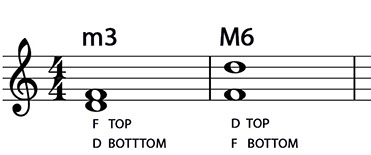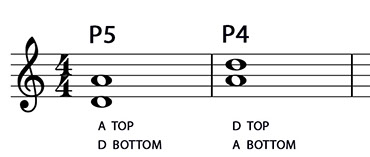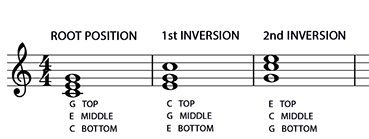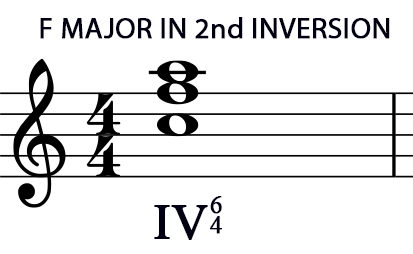
HOSTS- Jeremy Burns, Matthew Scott Phillips
TYPE- Theory
DURATION- 32:58
BUMPER MUSIC- "My Favorite Position", "My Favorite Position, Inverted" (Area 47 Music)
ANNOUNCER- Mike Cunliffe
When you invert a chord, you rearrange it's pitch order. This can serve several purposes. In this episode, we will cover inversions for triads and seventh chords, how they're built and how to listen for them. We will also cover figured bass, a means of representing them in analysis, and it's origin. We will also share several tips and tricks to help make more sense of this concept.
INVERSION- This occurs when a chord is arranged with a note other than the root note in the bass.
ROOT POSITION- A chord that is arranged, in pitch, with it's root note in the bass (lowest voice).
1st INVERSION- When a chord is voiced with the 3rd in the bass.
2nd INVERSION- When a chord is voiced with the 5th in the bass.
3rd INVERSION- When a chord is voiced with the 7th in the bass. Of course, this doesn't occur with triads (as you can only invert them twice).
FIGURED BASS- When a bass line, along with its suggested harmonies, is indicated by numerical figures rather than by written chords. This concept was given rise in the Baroque era (1600-1750A.D.) as a road map for organ accompanists. This way, they could follow the intended harmonies and bass lines but still take their own liberties with embellishments and counter melodies.
INVERTING INTERVALS
When we INVERT an interval, we change the arrangement of its pitches. Below, in measure 1, we see a D note on the bottom and an F on top.
This is the interval of a minor 3rd (m3). In measure 2, we see that the D has been moved up an octave to the space of the D note above the F. So, the first interval (m3) has now been INVERTED to that of
a major sixth (M6).

When we invert PERFECT intervals, they remain perfect. Below, we see a D note on the bottom and an A note on the top in the first measure. This is a PERFECT 5th. When we invert the two notes, as in the following measure, the interval becomes that of a PERFECT 4th. The same would occur with a PERFECT OCTAVE and UNISON.

When we invert an AUGMENTED interval it becomes DIMINISHED. Likewise, when we invert a DIMINISHED interval it becomes AUGMENTED.
In music theory, we study inversions to more fully understand the the relationships between two notes. In music practice, we might use them to add more color and interest to a passage of music or to
widen the texture of a chord.
ANY TIME YOU INVERT AN INTERVAL,
THE SUM OF THE ORIGINAL INTERVAL AND THAT OF THE NEW ONE WILL EQUAL THE NUMBER 9.
INVERTING TRIADS
When we invert TRIADS, we have 2 possible inversions from the original ROOT POSITION.

INVERTING 7th CHORDS
When we invert 7th chords, we have 3 possible inversions from the original ROOT POSITION. Below, we have a C major minor 7th chord
(C Dominant 7th) in root position in the first measure. Each of the following measures display the inversions that follow, in order, from the root up.

WHEN LISTENING FOR INVERSIONS:
- Sing the notes in your head.
- Listen for the PERFECT 4th.
- If the PERFECT 4th occurs between the TOP two notes, the chord is in 1st INVERSION.
- If the PERFECT 4th occurs between the two BOTTOM notes, the chord is in 2nd INVERSION.
- If you DON'T hear a PERFECT 4th, than the chord is in ROOT POSITION. This is because you are hearing that PERFECT 5th, instead, which will sound a bit more stable than its inversions.
FIGURED BASS
In the Baroque era, FIGURED BASS was used as a harmonic guideline for the accompanying keyboardist.
If we are in the key of C major, the below F major chord in 1st INVERSION would be implied by the Roman numeral IV with a superscript 6 on the upper right corner.

The superscript 6 suggests that the highest harmony is that of a 6th and the next lowest would be a 3rd. At some point the 3 was dropped because it is more or less implied.
If we are in the key of C major, the below F major chord in 2nd INVERSION would be implied by the Roman numeral IV with a superscript 6 on the upper right corner and a superscript 4 beneath it.

Below we see the FIGURED BASS symbols for the 7th CHORD. In this case, we are in the key of F major and the C7 chord will be a V chord.

-When listening for inversions, listen for where the PERFECT 4th is. If it lies between the two highest notes, this chord is in 1st INVERSION. If it lies between the two lowest notes, the chord is in 2nd INVERSION. If you can't detect a PERFECT 4th at all, there's a good chance the chord is in it's natural or ROOT POSITION, with the root in the bass voice, followed by the 3rd and then 5th.
